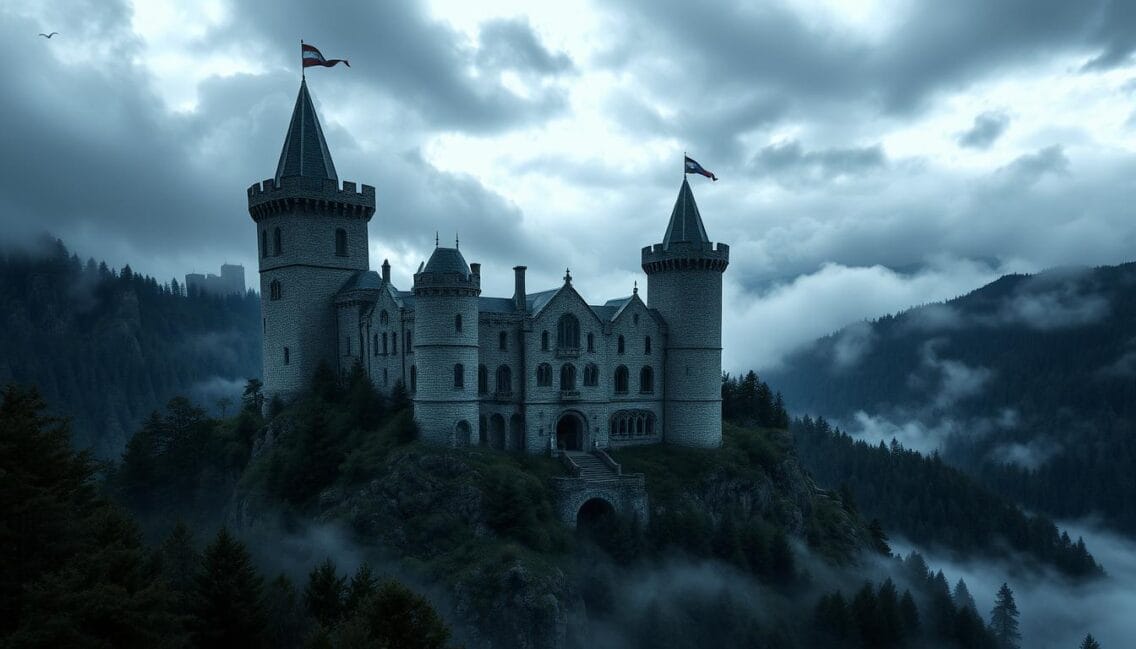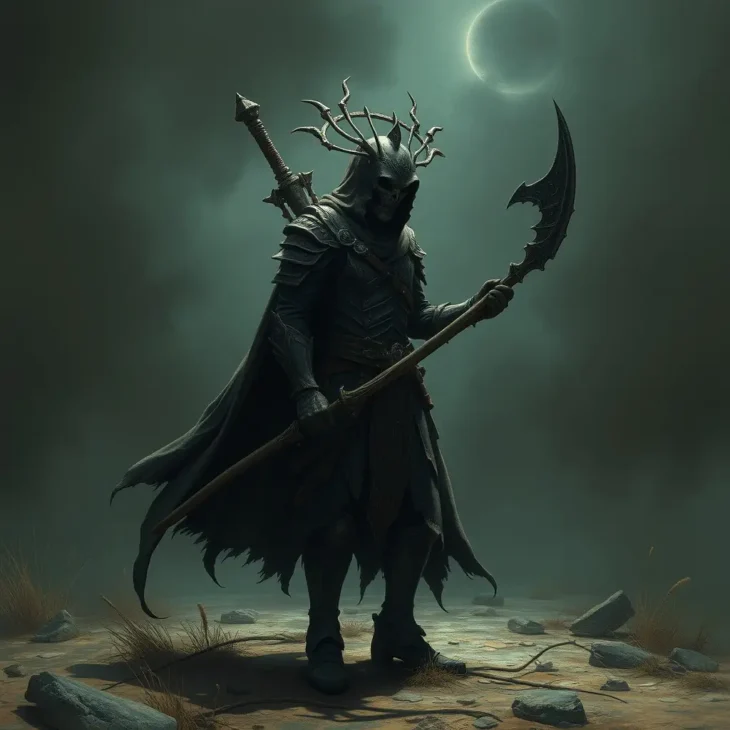The Witch of Moosham Castle

Moosham Castle sits high on a 1,079-meter mountain in Austria’s Lungau region. It’s a reminder of the area’s dark witchcraft and persecution history. First mentioned in 1191, this medieval castle was once the Prince-Archbishops of Salzburg’s headquarters. But, its dark past during the Zaubererjackl witch trials from 1675 to 1690 makes it infamous.
During those years, the castle was the site of 139 executions. This included 39 children as young as 10 and 113 men, many of whom were beggars. The trials ended in 1690, with extreme brutality. The youngest victim was 10, and the oldest was 80.
Key Takeaways
- Moosham Castle has a haunting history of witch hunts and executions, with 139 people killed during the Zaubererjackl trials from 1675 to 1690.
- The trials were marked by extreme brutality, with the youngest victim being just 10 years old and the oldest 80 years old.
- The castle’s dark past has made it one of the world’s most haunted locations, with a legacy of witchcraft and persecution.
- Moosham Castle’s architecture and history are deeply intertwined with the region’s Austrian witch lore and medieval European history.
- The castle’s role in the Zaubererjackl trials has cemented its reputation as a symbol of the darker aspects of the human experience.
The History and Architecture of Moosham Castle
Moosham Castle is in the heart of Austria, known for its medieval beauty. It sits at 1,079 meters (3,540 feet) high. From there, it looks over the Lungau region, showing off amazing views.
The castle started in the 1100s, making it 900 years old. In 1495, Prince-Archbishop Leonhard von Keutschach made big changes. By 1520, it became an important place for administration. It saw many battles, leaving a lasting impact.
The castle is famous for the Salzburg witch trials from 1675 to 1690. During this time, 139 people died, including 39 kids and 53 teens. Most of the victims were men, showing how society treated them.
“The method of execution during the witch trials involved slow torture before hanging or decapitation.”
Later, people believed werewolves were in the castle because of dead animals. This led to the castle’s residents being killed for being werewolves.
In the late 1700s, the castle was left to ruin. But in 1886, Count Johann Nepomuk Wilczek bought and fixed it up. He was into antiques and wanted to keep the castle’s history alive.
Austrian Witch Lore and the Zaubererjackl Trials
The history of Austrian witch trials is filled with dark tales. The Zaubererjackl Trials in Salzburg from 1675 to 1690 are a prime example. They started with Barbara Kollerin’s arrest for theft and sorcery. This led to a wave of fear that hit the most vulnerable, like homeless kids and teens.
The Beginning of the Witch Hunt
Barbara Kollerin’s confession implicated her son, Paul Jacob Koller, in a devil pact. This sparked a wave of persecution. 139 people were targeted, mostly men. Among them, 39 were kids aged 10 to 14, and 53 were teens and young adults.
Persecution of the Innocent
The Zaubererjackl Trials show the cruel fate of the innocent. All but two victims were beggars, showing how vulnerable the poor were in 17th-century Austria. The youngest victim was 10-year-old Hannerl, and the oldest was 80-year-old Margarethe Reinberg.
Methods of Torture and Execution
The witch trials were incredibly brutal. Before their deaths, all 139 victims faced terrible torture. This included hand amputation, branding, hanging, decapitation, and being burned alive. In 1681, 109 people lost their lives in these trials, marking a dark year in Austrian history.
The Zaubererjackl Trials stand as a sobering reminder of the fragility of human rights and the devastating consequences of unchecked fear and prejudice.
The Legend of Wizard Jackl and His Young Followers
The Austrian witch lore around Moosham Castle centers on Wizard Jackl, also known as Paul Jacob Koller. Authorities during the Salzburg Witch Trials were afraid of his supposed cruelty. They chose not to capture him directly but instead arrested his followers, mostly homeless kids and teens.
The search for Jackl’s gang led to wild stories about his powers. This added to the witch hunt frenzy. By the end of the Jackl saga in Salzburg, over 167 people lost their lives. Many were tortured to confess and believed to be driven by the devil.
“The majority of those who lost their lives in these witch hunts and pogroms were young males, with half of them being teenagers. People without means, such as vagrants and beggars, were disproportionately targeted for accusations and persecution during these events.”
Moosham Castle hosts an exhibition on the Jackl myth and Salzburg’s witches and sorcerers. It has been open to visitors exploring the dark history of the area. Playwright Felix Mitterer was inspired by Heinz Nagl’s dissertation to write “The Devil’s Children” about the witch trials. This play keeps Wizard Jackl and his followers’ legend alive.
Life and Death Within Castle Walls
Moosham Castle, in the heart of medieval Europe, was more than a grand building. It was a center of complex and scary activities. The castle was home to the episcopal burgrave, who played a key role in the witch trials of the time.
Daily Castle Operations
The castle’s daily life was a mix of work and harsh justice. The burgrave oversaw the legal process, including trials and punishments for witchcraft. The dungeons and torture chambers were places of great horror, where witches were tortured to get confessions.
The Role of the Burgrave
The burgrave was a powerful figure in Moosham Castle. He had the power to arrest, imprison, and execute those accused of witchcraft. His role was at the center of the witch hunt in medieval Europe.
Imprisonment and Punishment
Those accused of witchcraft faced a living hell in the castle’s cells and torture chambers. They were subjected to cruel methods like sleep deprivation and the rack. The worst punishment was being burned alive at the stake.
After the trials, the castle went back to its usual work until 1790. But the dark history of the Moosham Castle witch hunts is forever remembered in medieval Europe history.
The Werewolf Legends of Moosham
After the Salzburg Witch Trials at Moosham Castle ended, a new horror chapter began. In the late 18th century, the castle was in ruins. Locals in Austria reported mysterious deaths of deer and cattle.
They were afraid and blamed the castle’s residents for being werewolves. This led to the capture and murder of those accused in the castle courtyard. The werewolf legend made Moosham Castle even more haunted.
Today, people at Moosham Castle experience strange things. They feel unseen hands and hear footsteps and doors slamming. The castle’s dark history, from witch trials to werewolf legends, is unforgettable.
Source Links
- https://thelittlehouseofhorrors.com/moosham-castle/ – Moosham Castle – The Little House of Horrors
- https://en.wikipedia.org/wiki/Moosham_Castle – Moosham Castle
- https://darktourists.com/moosham-castle-dark-tourism-austria/ – Inside Moosham Castle – Witch Trials & Werewolves – Dark Tourists
- https://whenthecatsaway.net/category/europe/austria/moosham-castle/ – Moosham Castle – When the Cat’s Away…
- https://en.wikipedia.org/wiki/Zaubererjackl_witch_trials – Zaubererjackl witch trials
- https://theravenreport.com/2017/10/27/hidden-witchcraft-how-the-magic-jackel-delivered-death-by-fear/ – Hidden Witchcraft: How The Magic Jäckel Scared Europe To Death
- https://gothicbitemagazine.ca/2023/10/30/the-witch-trial-of-salzburg-in-austria/ – The Witch Trial Of Salzburg In Austria
- https://www.streetroots.org/news/2021/10/06/sorcerer-jackl – ‘Sorcerer Jackl’ tells a dark chapter in Salzburg’s history
- https://www.historyanswers.co.uk/medieval-renaissance/8-haunted-castles-you-need-to-visit-in-this-life-or-the-next/ – 8 Haunted Castles You Need to Visit in This Life or the Next | All About History
- https://www.salzburg-burgen.at/fileadmin/user_upload/Allgemeine_Files/2020/BUS_Gruppenplaner_2020EN.pdf – PDF
- https://hookofabook.wordpress.com/2017/10/26/featured-guest-article-the-witch-of-vienna-by-cat-cavendish/ – Featured Guest Article – The Witch of Vienna by Cat Cavendish
- https://www.princemichaelschronicles.com/the-witches-well-gleichenberg-styria-austria/ – The Witches’ Well, Gleichenberg, Styria, Austria – Michael of Greece
- https://gothicbitemagazine.ca/2022/11/16/the-moosham-castle-the-cruelest-trial-in-witch-hunt-history/ – The Moosham Castle The Cruelest Trial In Witch Hunt History
- https://www.aesu.com/blog/the-lingering-spirits-of-moosham-castle-in-austria-by-aesu-your-travel-experts/ – The Lingering Spirits of Moosham Castle in Austria by AESU, your Travel Experts – AESU



